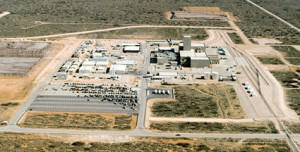NukesU.S. planning expansion of nuclear production in the face of safety concerns
Despite the release of a damning report regarding the 14 February nuclear waste accident at the Waste Isolation Pilot Plant (WIPP) near Carlsbad, New Mexico by the U.S. Department of Energy (DOE), the government is planning ramped-up production of nuclear weapons cores, a move which is raising red flags for those calling for reform of nuclear production and storage procedures.

Surface of the underground WIPP facility // Source: ucsb.edu
Despite the release of a damning report regarding the 14 February nuclear waste accident at the Waste Isolation Pilot Plant (WIPP) near Carlsbad, New Mexico by the U.S. Department of Energy (DOE), the government is planning ramped-up production of nuclear weapons cores, a move which is raising red flags for those calling for reform of nuclear production and storage procedures.
As thee Guardian reports, the February incident, which exposed twenty-two workers to radioactivity and led to the closure of the facility, has led the DOE to recommend a 7,000-point checklist which must be met before the site could be reopened. It is estimated that in order to put the plant on track, the cost would be in the billions. A separate study found that many nuclear facilities were unprepared to respond to emergencies, faced environmental violations, and even had employees sentenced for espionage.
Despite this, the Department of Defense (DOD), the White House, members of Congress, and the Los Alamos National Laboratory (LANL) are all pushing for a ramped up production of nuclear weapons cores not seen since the days of the cold war. In August, the Congressional Research Service (CRS) outlined their recommendations for more production and storage by 2030. The measure has been adopted into the 2015 Defense Authorization Act which will invest $355 billion in nuclear weapons development over the next three decades.
“We view the Obama administration’s position as increasingly hypocritical,” said Jay Coghlan of New Mexico Nuclear Watch, citing the president’s earlier promises of drastically shrinking the nuclear weapons stockpile. “Obama’s proposed 2015 budget is the highest ever for nuclear weapons research and production. And at the same time they’re cutting nonproliferation budgets to pay for it.”
Many, however, do not forget the legacy of the WIPP closing. James Doyle, a former scientist in the Nuclear Nonproliferation Division at LANL, has criticized the program in a now classified article — citing a lack of research and a lack of need for further production. Even the U.S. Navy has questioned the need for further production of nuclear weapons cores, suggesting that weapons could be updated for a fraction of the cost.
Interestingly, Doyle was also dismissed from his post this summer for his criticism.
“I think there are plenty of people at the lab who share my view that are now even less likely to write an article like that now that this has happened to me,” he said.
Additionally, some in New Mexico’s environmental department have also expressed frustration. Department secretary Ryan Flynn has state that both the LANL and the DOE have proven “inconsistent communicators” in the continued investigation of the contamination at WIPP. His organization and other non-profit groups are determined to see that the intensive funding and government support for more production doesn’t steam roll reform.
“We need to get information in order to do our job, first and foremost protecting the public from any risks that are posed by any of these activities,” Flynn added, “We’re going to get [it] voluntarily or involuntarily.”
